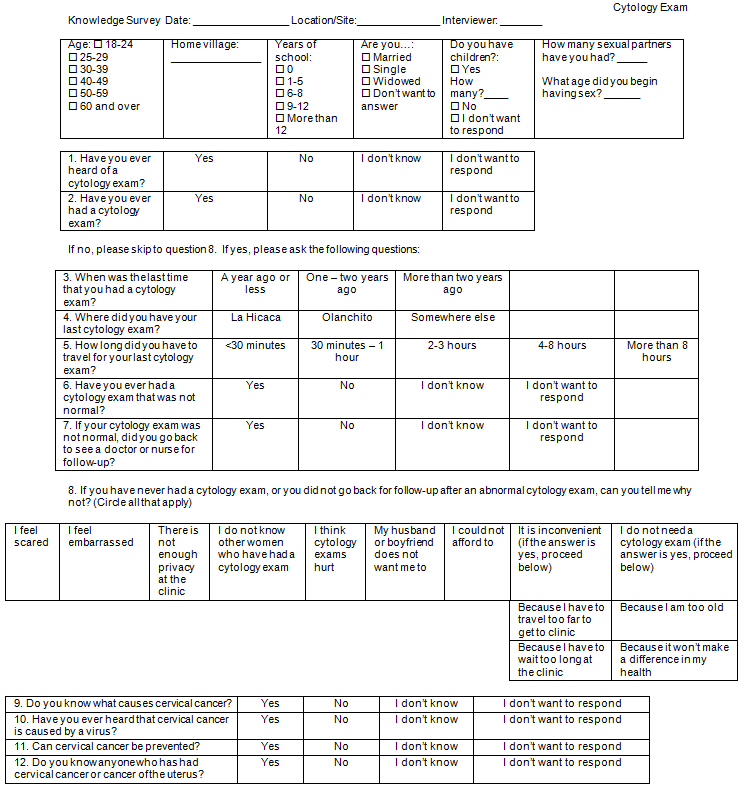Cervical cancer is estimated to be the leading cause of cancer mortality in Honduras1. In 2012, the incidence of cervical cancer in Honduras was about 23%1 and the mortality rate was 15.7%1. Cervical cancer mortality rates in Latin American countries are seven times higher than in North America2. Even though Honduras has a national plan regarding cervical cancer screening and treatment3, there is great variability in cervical cancer screening.
Cervical cancer is only one health issue faced by the Honduran people; 15% of Hondurans have no access to healthcare coverage4 and 58% of the rural-dwelling population of Honduras lives in extreme poverty5. Rural Hondurans have many health disparities compared to their urban counterparts, including cervical cancer5.
The Papanicolaou test (pap smear) is the cervical cancer screen in Honduras. The reported cervical cancer screening rate for Honduran women is only 42%3. Barriers to screening fall into two broad categories: individual and structural/systemic. These barriers broadly encompass the obstacles that hinder rural Honduran women from accessing cervical cancer screening services.
Objectives
The purpose of this study was to assess attitudes, perceptions and barriers to cervical cancer screening in the rural mountainous area of Yoro, Honduras. Responses between La Hicaca and surrounding villages in Yoro were examined and compared.
Since 2005, Virginia Commonwealth University's Global Health and Health Disparities Program (GH2DP) has traveled to Yoro and partnered with the Ministry of Health and local leaders to provide medical care. The GH2DP brigade provides basic medical services to the citizens of La Hicaca, Yoro and the 17 surrounding villages. Previous studies have demonstrated that disparities to accessing health care and a high disease burden were present within these communities6,7. La Hicaca and environs have a population of approximately 2000 people8. During the 2014 GH2DP brigade, two female surveyors read a face-to-face, voluntary, anonymous questionnaire to a convenience sample of women who came to the clinic. All women were 18 years or older and were not known to be pregnant.
The questionnaire had 20 questions and was divided into four sections (Appendix A). Part 1 collected information on demography. Part 2 sought information regarding risk factors associated with cervical cancer. Part 3 evaluated the barriers to obtaining cervical cancer screening services. When a respondent answered that she had never been screened or had not returned for follow-up screening, the interviewers read a list of nine options that a woman could choose as to why she had not been screened or re-screened. Each respondent was able to choose multiple reasons. Part 4 assessed women's knowledge of what causes cervical cancer and their beliefs about whether or not it can be prevented.
Because Yoro is rural and rugged, many women face a travel barrier when attempting to access healthcare services. Many survey respondents made this journey to the clinics in either La Hicaca or Lomitas, a satellite clinic. La Hicaca was wealthy compared to its surrounding villages (although the community still lacks electricity and running water), and the people who lived there had the privilege of having a health clinic in their community (in addition to the annual clinic GH2DP runs). Because of this proximity to the clinic and relative wealth of La Hicaca, this study explored the differences between the women of La Hicaca and the surrounding villages in terms of risk factors, access to and knowledge of cervical cancer screening. This study also analyzed whether past pap smear recipients had greater knowledge of cervical cancer and its prevention.
The survey analysis was done using SAS statistical software v9.4 (SAS Institute; http://www.sas.com). Descriptive analysis was done using frequency counts, percentage responses, and mean values. Proportions were compared using χ2 testing and Fisher's exact tests and compared means using the student's t-test.
Ethics approval
The study and questionnaire were approved by the Virginia Commonwealth University Institutional Review Board panel (approval number HM20000686).
One hundred and forty-six surveys were completed. Survey respondents are detailed in Table 1. Figure 1 summarizes self-reported pap smear by age group. Older respondents were more likely to have been screened than respondents aged 18-24 years (p≤0.0001). Table 2 summarizes the comparative statistics among all survey respondents. Respondents knowledgeable about cervical cancer prevention were more likely to have ever had a pap smear (p=0.0054). Table 3 highlights the differences between La Hicaca and the surrounding villages in relation to risk factors, knowledge of and access to cervical cancer screening services. Respondents from surrounding villages had to travel further to visit a pap smear clinic than did respondents from La Hicaca (p<0.0001). Respondents from La Hicaca were significantly more likely to receive the results of their pap smears than were respondents from the surrounding villages (86% (19/22) vs 60% (42/70), p=0.0367). The respondents of the surrounding villages were more likely to believe that cervical cancer is preventable than were the respondents of La Hicaca (82% (95/116) vs 60% (18/30), p=0.0106).
Table 1: Survey respondent characteristics
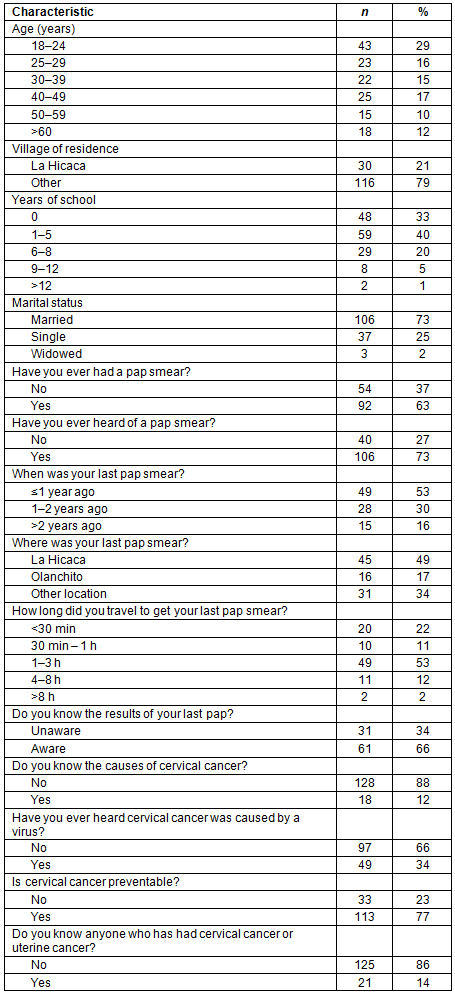
Table 2: Comparative statistics among all survey respondents
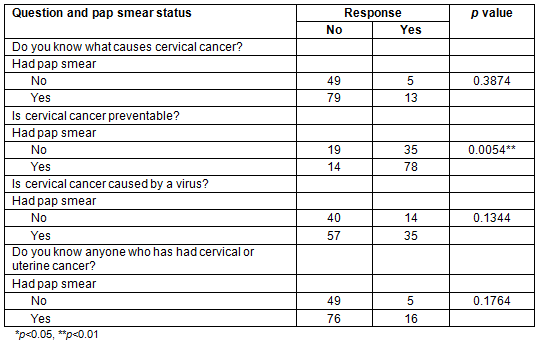
Table 3: Risk factors, knowledge of and access to cervical cancer screening services, La Hicaca vs surrounding villages
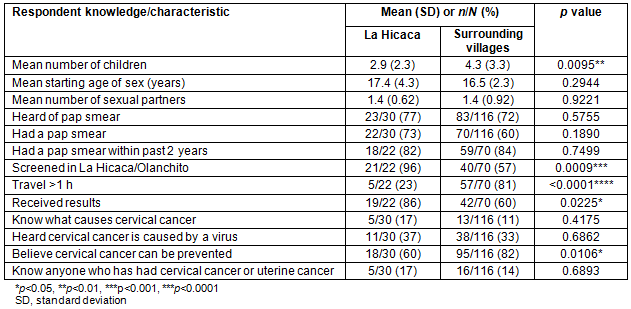
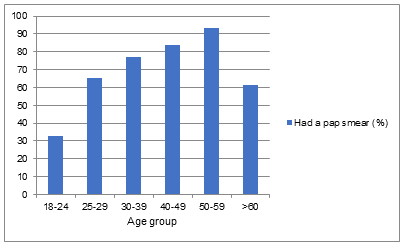
Figure 1: Self-reported pap smear (%) by age group.
Barriers to screening
Of the respondents with no prior cervical cancer screening, nearly three-quarters (40/54 respondents, 74%) had never heard of a pap smear. The most common barrier was fear of being screened (15 respondents). Other reported barriers were inconvenience of having to travel a great distance (six respondents) and belief that getting screened wouldn't make a difference (five respondents).
Of the five women who answered 'yes' to having received an abnormal pap smear and failed to follow up, one respondent said that it was too far to travel and that she did not have enough money to do so. The others offered no specific reason for failure to follow up.
Discussion
Ninety-three percent of cervical cancer cases are likely to be preventable by screening and vaccination9. Although nearly 75% of the respondents were aware of cervical cancer screening, many women from both La Hicaca and the surrounding villages had never been screened. Further, of the women who had undergone cervical cancer screening, the majority were unaware of the cause of cervical cancer. Women who self-reported undergoing pap smears were more likely to know the preventability of cervical cancer. This suggests that knowledge regarding cervical cancer prevention may be sufficient motivation for many women to undergo screening, regardless of a thorough understanding of the screening process.
More than one-third of the women who had undergone cervical cancer screening in the survey population did not know the results of their pap smears. Traditional methods of follow-up are limited in Yoro given that most residents have no electricity or phone lines. The burden thus lies on the Ministry of Health to relay pap smear results to all women who have completed cervical cancer screening.
Travel time was a considerable barrier to accessing healthcare services in Yoro6. The World Health Organization encourages mobile clinics where screen-and-treat methods could be performed as a possible solution to poor access10. The GH2DP medical brigades have been successful in setting up satellite clinics in remote areas of Yoro, thus mobile cervical cancer screening may be a viable component to these programs.
Fear was the most common barrier to cervical cancer screening3,11-13. Agurto, et al. found that women believed it was better not to know death was coming than to know it was coming and not be able to do anything about it14. This sentiment suggests that strategies to educate Honduran women on understanding the diversity of screening results and benefits of pap screening are urgently needed.
This study had several limitations. The screening rate among this sample may have been artificially high due to selection bias, as only women who came to the clinic were surveyed. These women may be more likely to be screened for cervical cancer. Another limitation may be recall bias, because women may not remember exactly when they were last screened, especially if the last screen was many years prior to the survey. While women were invited to complete the questionnaire after clinic, it is possible that they felt coerced into completing the questionnaire. The results may thus not be generalized.
This study had several strengths. All surveys were conducted within an 8-day timeframe. Two trained surveyors conducted the interviews. By reading the surveys to the respondents, potential confusion was reduced and the effect of low literacy rates was minimized.
This study adds to the small body of literature on cervical cancer in Honduras and Central America and may be relevant to other developing regions with similar health disparity and resource pressures. These survey findings raise new questions about the optimal strategy for consistently performing cervical cancer screening in resource poor settings. It is hoped that this research can aid Honduran health officials in policy change, and that these findings will guide regional and collaborative effort to improve cervical cancer screening services.
Rural Honduran women aware of cervical cancer prevention were more likely to be screened. In addition, women who had heard of cervical cancer screening, but chose not be screened, reported fear, travel time and belief in the futility of pap screening process as barriers to screening. Strategies to educate Honduran women on understanding the benefits of pap screening and minimization of structural barriers to screening access are needed.
References
1. International Agency for Research on Cancer. (Internet) 2014. Available: http://globocan.iarc.fr/Pages/fact_sheets_population.aspx?country=340 (Accessed 10 September 2014).
2. Pan American Health Organization. Regional strategy and action plan for cervical cancer prevention and control in Latin America and the Caribbean. (Internet) 2010. Available: http://www.rho.org/files/PAHO_Regional_Strategy_2010.pdf (Accessed 10 September 2014).
3. Pan American Health Organization. Cervical cancer prevention and control programs: a rapid assessment in 12 countries of Latin America. (Internet) 2010. Available: http://www.paho.org/hq/index.php?option=com_docman&task=doc_view&gid=16119&Itemid (Accessed 30 September 2015).
4. Soneji S, Fukui N. Socioeconomic determinants of cervical cancer screening in Latin America. Revista Panamericana de Salud Pública 2013; 33(3): 174-182. https://doi.org/10.1590/S1020-49892013000300003
5. World Health Organization. Country cooperation strategy at a glance: Honduras. (Internet) 2012. Available: http://www.who.int/countryfocus/cooperation_strategy/ccsbrief_hnd_en.pdf (Accessed 29 September 2015).
6. Whitney R, Stevens M, Bearman G. Medical relief services in rural Honduras: an assessment of healthcare needs and delivery with a comparison of two neighboring communities. Webmed Central Public Health 2010; 1(11): WMC001146.
7. Donovan S, Stevens M, Sanogo K, Masroor N, Bearman G. Knowledge and perceptions of Chagas disease in a rural Honduran community. Rural and Remote Health (Internet) 2014 ;14(3): 2845. Available: www.rrh.org.au (Accessed 30 September 2015).
8. Stevens M. Global Health and Health Disparities Program (GH2DP): Yoro, Honduras. (Internet) 2013. Available: http://www.gh2dp.vcu.edu/Yoro,_Honduras.html (Accessed 23 October 2013).
9. Centers for Disease Control and Prevention. Cervical cancer is preventable. (Internet) 2014. Available: https://www.cdc.gov/vitalsigns/cervical-. cancer/index.html (Accessed 30 September 2015).
10. World Health Organization. Comprehensive cervical cancer control: a guide to essential practice. (Internet) 2014. Available: http://apps.who.int/iris/bitstream/10665/144785/1/9789241548953_eng.pdf.
11. Agurto S, Arrossi S, White P, Coffey P, Dzubad I, Bingham A, et al. Involving the community in cervical cancer prevention programs. International Journal of Gynecology & Obstetrics 2005; 89(2): S38-S45.
12. Claeys P, Gonzalez C, Gonzalez M, Page H, Bello R, Temmerman M. Determinants of cervical cancer screening in a poor area: results of a population-based survey in Rivas, Nicaragua. Tropical Medicine & International Health 2002; 7(11): 935-941. https://doi.org/10.1046/j.1365-3156.2002.00953.x
13. Almonte M, Albero G, Molano M, Carcamo C, García PJ, Pérez G. Risk factors for human papillomavirus exposure and co-factors for cervical cancer in Latin America and the Caribbean. Vaccine 2008; 26(S11): L16-L36. https://doi.org/10.1016/j.vaccine.2008.06.008
14. Agurto I, Bishop A, Sánchez G, Betancourt Z, Robles S. Perceived barriers and benefits to cervical cancer screening in Latin America. Preventative Medicine 2004; 39(1): 91-98. https://doi.org/10.1016/j.ypmed.2004.03.040
_____________________________
Appendix A: Study questionnaire on risk factors for and knowledge of causes of cervical cancer, and barriers to obtaining cervical cancer screening services
